Abstract
The effect of bacterial lipopolysaccharide (LPS) on the expression of class I and II major histocompatibility complex (MHC) molecules on the surface of cultured human umbilical vein endothelial cells (HUVEC) was determined by indirect immunofluorescent staining followed by flow cytometric analysis. LPS at concentrations higher than 0.01 micrograms/ml augmented class I MHC (HLA-A,B,C) expression on HUVEC in a concentration-dependent manner. Optimal augmentation, approximately sixfold compared with control, was seen with 10 micrograms/ml of LPS. Time-course experiments indicated that the augmentation was maximal on Day 4. In contrast, LPS had no effect on the induction of class II MHC (HLA-DR) molecules and at concentrations higher than 0.01 micrograms/ml inhibited the interferon-gamma(IFN-gamma)-induced class II MHC expression. The inhibition was about 60% at the concentration of 100 micrograms/ml of LPS. Interleukin-1 (IL-1) had a similar effect as LPS on class I and II MHC expression. However, LPS appeared to affect MHC expression directly and not through production of IL-1 or cyclo-oxygenase pathway products, since anti-IL-1 antibodies or an inhibitor of cyclo-oxygenase pathway products, indomethacin, failed to reverse the effects of LPS. These data stress the role of LPS as a direct modulatory factor of class I and II MHC expression on endothelial cells during the development of immune and inflammatory response against Gram-negative bacteria.
Full text
PDF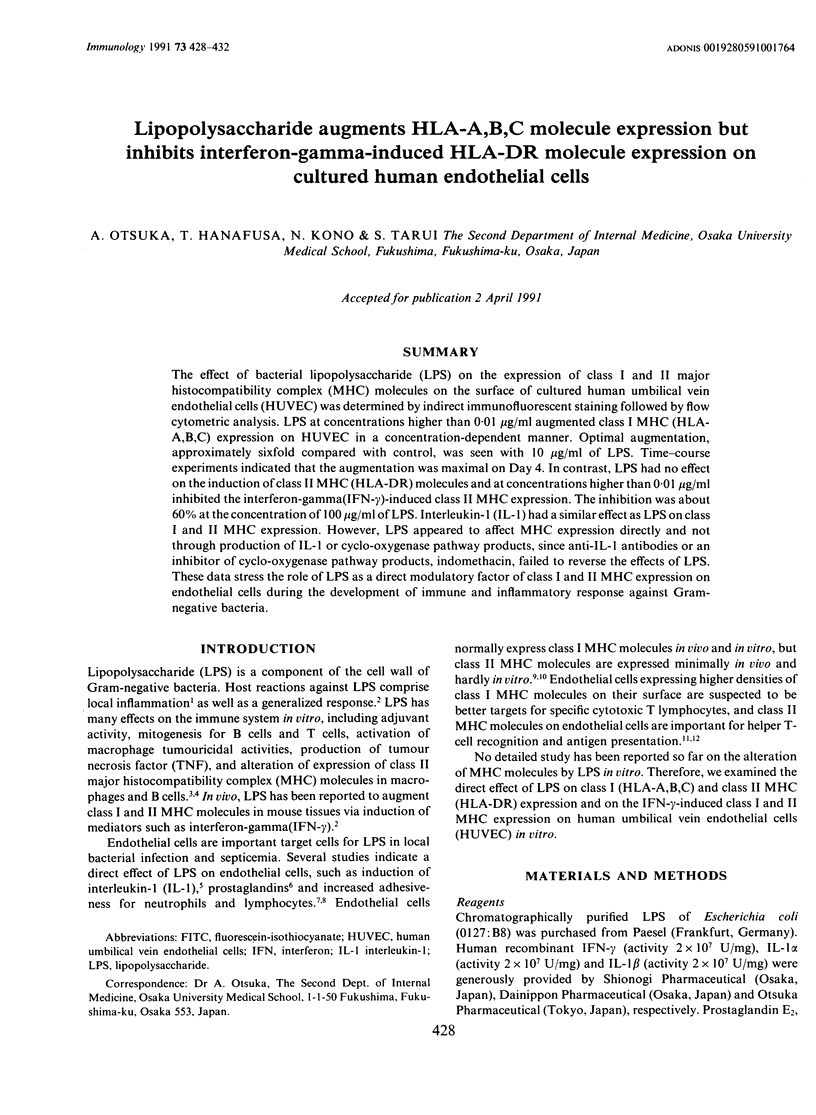
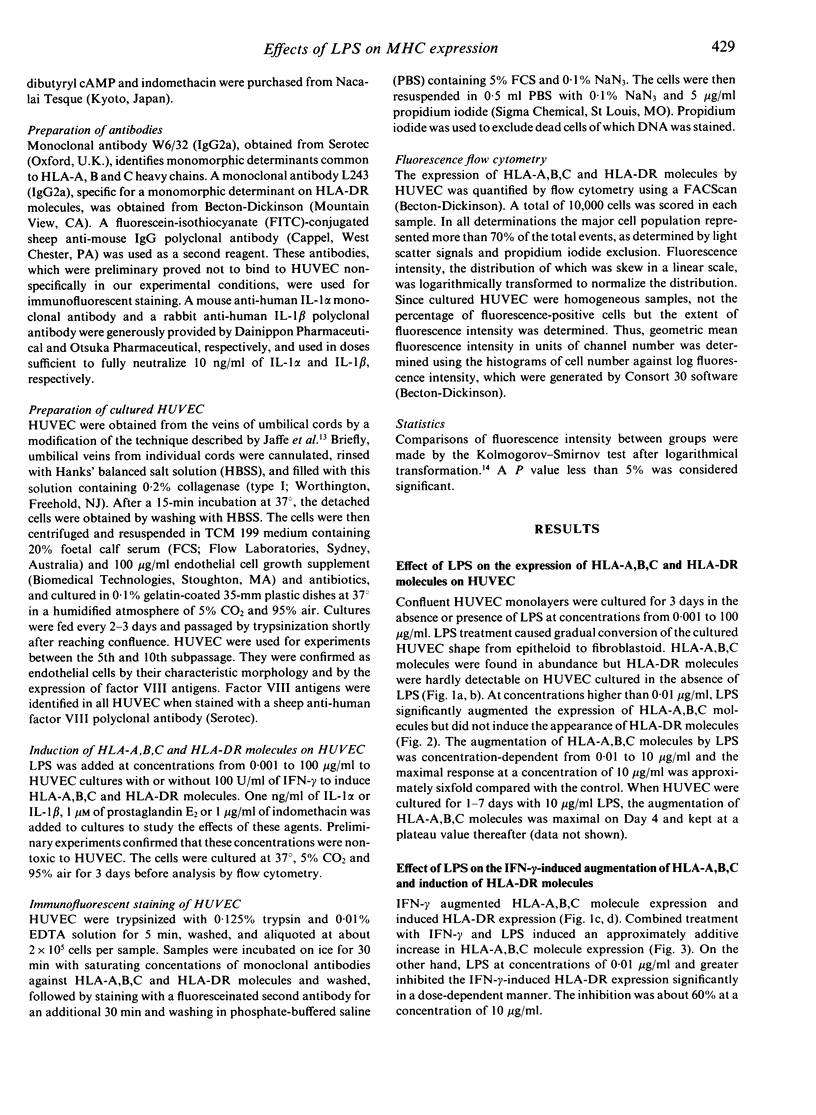
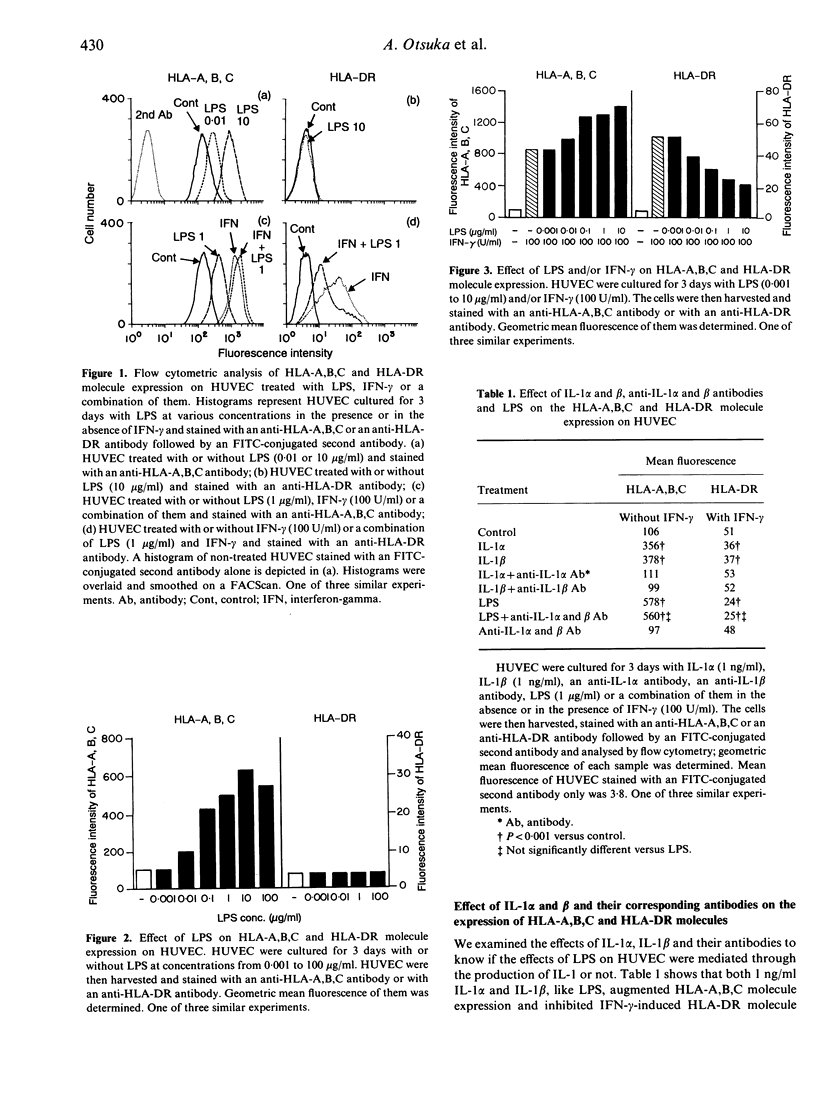
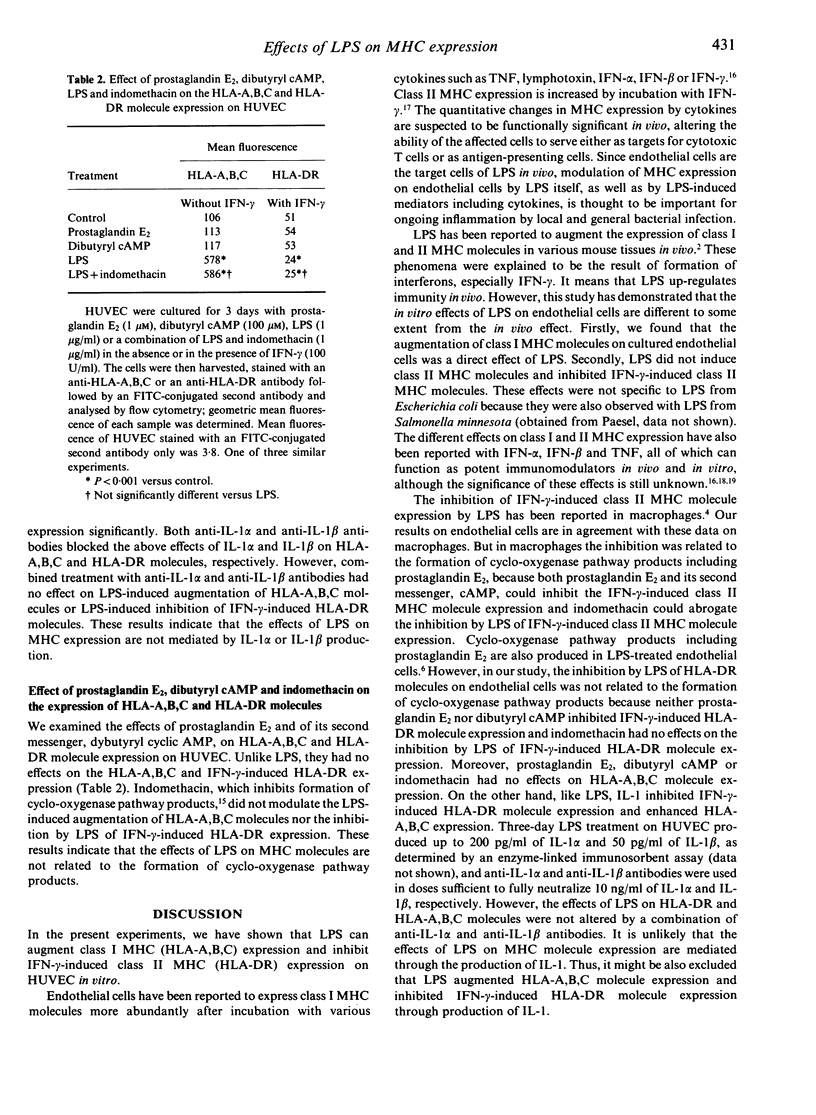
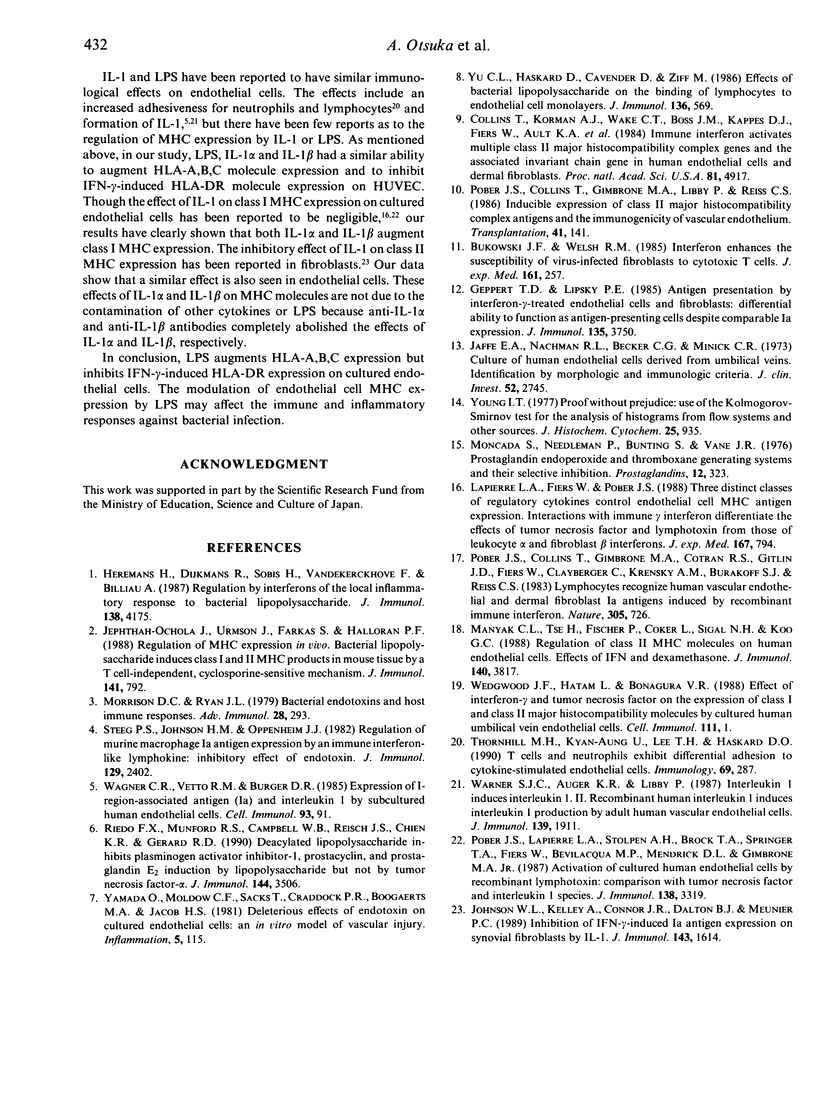
Selected References
These references are in PubMed. This may not be the complete list of references from this article.
- Bukowski J. F., Welsh R. M. Interferon enhances the susceptibility of virus-infected fibroblasts to cytotoxic T cells. J Exp Med. 1985 Jan 1;161(1):257–262. doi: 10.1084/jem.161.1.257. [DOI] [PMC free article] [PubMed] [Google Scholar]
- Collins T., Korman A. J., Wake C. T., Boss J. M., Kappes D. J., Fiers W., Ault K. A., Gimbrone M. A., Jr, Strominger J. L., Pober J. S. Immune interferon activates multiple class II major histocompatibility complex genes and the associated invariant chain gene in human endothelial cells and dermal fibroblasts. Proc Natl Acad Sci U S A. 1984 Aug;81(15):4917–4921. doi: 10.1073/pnas.81.15.4917. [DOI] [PMC free article] [PubMed] [Google Scholar]
- Geppert T. D., Lipsky P. E. Antigen presentation by interferon-gamma-treated endothelial cells and fibroblasts: differential ability to function as antigen-presenting cells despite comparable Ia expression. J Immunol. 1985 Dec;135(6):3750–3762. [PubMed] [Google Scholar]
- Heremans H., Dijkmans R., Sobis H., Vandekerckhove F., Billiau A. Regulation by interferons of the local inflammatory response to bacterial lipopolysaccharide. J Immunol. 1987 Jun 15;138(12):4175–4179. [PubMed] [Google Scholar]
- Jaffe E. A., Nachman R. L., Becker C. G., Minick C. R. Culture of human endothelial cells derived from umbilical veins. Identification by morphologic and immunologic criteria. J Clin Invest. 1973 Nov;52(11):2745–2756. doi: 10.1172/JCI107470. [DOI] [PMC free article] [PubMed] [Google Scholar]
- Jephthah-Ochola J., Urmson J., Farkas S., Halloran P. F. Regulation of MHC expression in vivo. Bacterial lipopolysaccharide induces class I and II MHC products in mouse tissues by a T cell-independent, cyclosporine-sensitive mechanism. J Immunol. 1988 Aug 1;141(3):792–800. [PubMed] [Google Scholar]
- Johnson W. J., Kelley A., Connor J. R., Dalton B. J., Meunier P. C. Inhibition of IFN-gamma-induced Ia antigen expression on synovial fibroblasts by IL-1. J Immunol. 1989 Sep 1;143(5):1614–1618. [PubMed] [Google Scholar]
- Lapierre L. A., Fiers W., Pober J. S. Three distinct classes of regulatory cytokines control endothelial cell MHC antigen expression. Interactions with immune gamma interferon differentiate the effects of tumor necrosis factor and lymphotoxin from those of leukocyte alpha and fibroblast beta interferons. J Exp Med. 1988 Mar 1;167(3):794–804. doi: 10.1084/jem.167.3.794. [DOI] [PMC free article] [PubMed] [Google Scholar]
- Manyak C. L., Tse H., Fischer P., Coker L., Sigal N. H., Koo G. C. Regulation of class II MHC molecules on human endothelial cells. Effects of IFN and dexamethasone. J Immunol. 1988 Jun 1;140(11):3817–3821. [PubMed] [Google Scholar]
- Moncada S., Needleman P., Bunting S., Vane J. R. Prostaglandin endoperoxide and thromboxane generating systems and their selective inhibition. Prostaglandins. 1976 Sep;12(3):323–335. doi: 10.1016/0090-6980(76)90014-9. [DOI] [PubMed] [Google Scholar]
- Morrison D. C., Ryan J. L. Bacterial endotoxins and host immune responses. Adv Immunol. 1979;28:293–450. doi: 10.1016/s0065-2776(08)60802-0. [DOI] [PubMed] [Google Scholar]
- Pober J. S., Collins T., Gimbrone M. A., Jr, Cotran R. S., Gitlin J. D., Fiers W., Clayberger C., Krensky A. M., Burakoff S. J., Reiss C. S. Lymphocytes recognize human vascular endothelial and dermal fibroblast Ia antigens induced by recombinant immune interferon. Nature. 1983 Oct 20;305(5936):726–729. doi: 10.1038/305726a0. [DOI] [PubMed] [Google Scholar]
- Pober J. S., Collins T., Gimbrone M. A., Jr, Libby P., Reiss C. S. Inducible expression of class II major histocompatibility complex antigens and the immunogenicity of vascular endothelium. Transplantation. 1986 Feb;41(2):141–146. doi: 10.1097/00007890-198602000-00001. [DOI] [PubMed] [Google Scholar]
- Pober J. S., Lapierre L. A., Stolpen A. H., Brock T. A., Springer T. A., Fiers W., Bevilacqua M. P., Mendrick D. L., Gimbrone M. A., Jr Activation of cultured human endothelial cells by recombinant lymphotoxin: comparison with tumor necrosis factor and interleukin 1 species. J Immunol. 1987 May 15;138(10):3319–3324. [PubMed] [Google Scholar]
- Riedo F. X., Munford R. S., Campbell W. B., Reisch J. S., Chien K. R., Gerard R. D. Deacylated lipopolysaccharide inhibits plasminogen activator inhibitor-1, prostacyclin, and prostaglandin E2 induction by lipopolysaccharide but not by tumor necrosis factor-alpha. J Immunol. 1990 May 1;144(9):3506–3512. [PubMed] [Google Scholar]
- Steeg P. S., Johnson H. M., Oppenheim J. J. Regulation of murine macrophage Ia antigen expression by an immune interferon-like lymphokine: inhibitory effect of endotoxin. J Immunol. 1982 Dec;129(6):2402–2406. [PubMed] [Google Scholar]
- Thornhill M. H., Kyan-Aung U., Lee T. H., Haskard D. O. T cells and neutrophils exhibit differential adhesion to cytokine-stimulated endothelial cells. Immunology. 1990 Feb;69(2):287–292. [PMC free article] [PubMed] [Google Scholar]
- Wagner C. R., Vetto R. M., Burger D. R. Expression of I-region-associated antigen (Ia) and interleukin 1 by subcultured human endothelial cells. Cell Immunol. 1985 Jun;93(1):91–104. doi: 10.1016/0008-8749(85)90391-0. [DOI] [PubMed] [Google Scholar]
- Wedgwood J. F., Hatam L., Bonagura V. R. Effect of interferon-gamma and tumor necrosis factor on the expression of class I and class II major histocompatibility molecules by cultured human umbilical vein endothelial cells. Cell Immunol. 1988 Jan;111(1):1–9. doi: 10.1016/0008-8749(88)90046-9. [DOI] [PubMed] [Google Scholar]
- Yamada O., Moldow C. F., Sacks T., Craddock P. R., Boogaerts M. A., Jacob H. S. Deleterious effects of endotoxin on cultured endothelial cells: an in vitro model of vascular injury. Inflammation. 1981 Jun;5(2):115–126. doi: 10.1007/BF00914201. [DOI] [PubMed] [Google Scholar]
- Young I. T. Proof without prejudice: use of the Kolmogorov-Smirnov test for the analysis of histograms from flow systems and other sources. J Histochem Cytochem. 1977 Jul;25(7):935–941. doi: 10.1177/25.7.894009. [DOI] [PubMed] [Google Scholar]
- Yu C. L., Haskard D., Cavender D., Ziff M. Effects of bacterial lipopolysaccharide on the binding of lymphocytes to endothelial cell monolayers. J Immunol. 1986 Jan;136(2):569–573. [PubMed] [Google Scholar]


